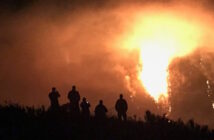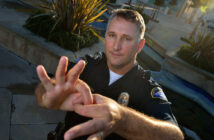Some cops tend to have a specialty — an area of enforcement they’re drawn to that they become known for among their peers and in the community.
There are those at the Tustin Police Department known for chasing down gang members and others who like to focus their attention on ensuring drivers are abiding by traffic safety laws.
Officer Javon Smith said he doesn’t have a specialty, but he earned an honor that has secured him the title of Tustin PD’s resident DUI officer.
Smith was honored this month by Mother’s Against Drunk Driving for arresting 47 drunken drivers in Tustin in 2015 — the most in the department last year.
“I’m not the DUI guy,” the 33-year-old said. “It just worked out that way last year. I just want to be very well-rounded.”
Smith attributes his numerous drunk driving arrests to teamwork, having great mentors and staying proactive on the nights where calls are quiet in Tustin.
“We help each other out and if someone is busy filing a report on another arrest, I might take over,” Smith said.

Officer Javon Smith is a former college football player and a current amateur MMA fighter. He has worked for Tustin PD for two years. Photo by Miguel Vasconcellos/Behind the Badge OC.
The Louisiana native and former collegiate running back joined Tustin PD two years ago after transferring from the Los Angeles County Sheriff’s Department.
He joined law enforcement for a reason he says may sound trite, but is genuine to the man he is.
“I’ve always had my own person mission goal,” he said. “I wanted to be an influence in the community I live and serve in. I wanted to be able to influence someone’s life, even if it’s just one person.”
Taking nearly 50 drunken drivers off the road in one year — close to one a week — is an undeniable impact.
The average person may assume there is not much skill to arresting an intoxicated driver, but they’d be wrong, Smith said.
It’s a multi-step process that involves being a keen observer and a solid writer.
Smith remembers the first drunken driving report he ever wrote.
Officer Jeremy Laurich, the cop Smith said is truly Tustin PD’s DUI expert, took one look at it, tore it up and made Smith start over.
“I swear, making that arrest seemed like it took forever,” Smith said. “Jeremy just looked at it and said, ‘What is this?’ Then he showed me the correct way to write a report.”
Making a DUI arrest must meticulously be documented with details accounting for why the officer made the arrest to how the driver failed a series of tests.
The results of chemical breath test or blood test are what they are, most do not challenge those results, however the reason for the initial stop is usually what gets challenged.
“You have to have a bullet-proof report so nobody can question it.”
Science-based field sobriety tests approved by the National Highway Safety Administration are conducted after Smith makes a stop for suspected DUI.
“With alcohol, the first thing that goes are your motor skills,” he said. “Everyone should be able to do these tests if they’re sober.”
In most cases, police offer a preliminary read on the driver’s blood alcohol content with a handheld breathalyzer, but that’s only part of the officer’s investigation.
A DUI investigation takes into consideration several aspects including any observed driving concerns, personal indicators such as odor of alcohol, impaired speech then performance on the field tests as well as the reading of the handheld breathalyzer.
Anything over a .08, the handcuffs come out and the suspect is taken to the department for more testing.

Office Javon Smith made the most DUI arrests in the department last year with 47. Photo by Miguel Vasconcellos/Behind the Badge OC
On a recent Friday shift, Smith patrolled his assigned Tustin streets looking for something to catch his eye.
He patrolled his assigned area, checking on areas where there exists a higher likelihood of drunk drivers, including bars and fast food restaurant parking lots..
“I always like to look at fast food places,” Smith said. “What do people want to eat when they’re drunk? Something quick and with a drive-thru.”
A little after 2 a.m., Smith was summoned to a traffic stop.
The driver had erratically been flipping his turn signals on and off and stopping at green lights so an officer pulled him over.
The 22-year-old driver told Smith he had four Stella Artois beers, but finished drinking several hours earlier.
The man had no license and was not driving his own vehicle.
Surprisingly, the suspect wasn’t terrible at the physical part of the field sobriety tests, but he struggled to follow basic instructions.
He continued to tell Smith he was nervous.
Smith accounts for that in all traffic stops. Even if sober, sometimes nerves can get the best of a driver on some of these tests, which is why police have the driver participate in several.
There is one test that is not impacted by nerves, poor balance or anything else a driver might offer up as an excuse for inadequate performance: the eye test.
Smith took out his pen with a light at the end and asked the driver to follow the light. The driver couldn’t focus, his eyes bouncing left to right before landing on the target.
“I can always tell by the eyes,” Smith said. “They never lie.”
The 22-year-old blew a .123 and was arrested on suspicion of drunken driving.
The man was respectful during the stop and stayed pretty quiet — a mellow DUI arrest by all accounts.
It’s not always that way.
Smith has many stories of the strange things he’s seen working weekend nights.
There are the people who lie and say they haven’t been drinking, then face-plant trying to exit their car.
One of Smith’s most memorable reports was a man who misunderstood the instructions on a test in which he was asked to walk nine steps, turn around and walk back.
When the intoxicated man hit step number nine he didn’t turn around, but instead walked backwards in a full-out moonwalk.
“I actually had to put in my report, ‘walked backwards like Michael Jackson’,” Smith said laughing. “Sometimes they just do crazy things.”
Then there are the people who are so drunk they relent to brutal honesty.
“I’ve had people say to me, ‘Yeah, I’m drunk. I should not be driving. I should go to jail’,” Smith said. “I say, ‘OK great, let’s go.’”
Although chuckling as he recalled some of the stories from previous DUI arrests, Smith is quick to point out that it is no laughing matter — there are very real consequences for people who get behind a wheel impaired.
“The potential for an intoxicated driver to hurt someone is very high,” Smith said. “I’ve responded to two fatal DUI crashes and two severe injury crashes in two years.
“You just have to stop these people because they are going to hurt or kill someone. There is Uber, there are taxis and it is all at the touch of a button on your phone. In this day and age, nobody should be driving drunk.”
 Behind the Badge
Behind the Badge



